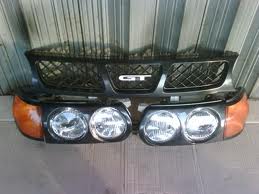

Tidy 60 series Starlets are becoming more difficult to acquire due, in part, to their age and proneness to rust, and due to the fact that many are being converted into track and rally cars, and are thus beginning to become a valuable collector's car. In 1980 the Starlet was facelifted to include square headlights and a second facelift followed in 1983 to incorporate a slant nose front end, and a lower hatch opening. Differential ratios depend on the trim model and market for each car, with 3.909:1 being common for vehicles with a 2K engine, 4.3:1 for European van models, 3.727 for Japanese van models, 3.417:1 for vehicles fitted with an automatic transmission, 3.583:1 for general applications with a 4K engine, and other ratios existing for various Japanese market vehicles. Vehicles fitted with a 2K engine received a smaller differential (X code, 5.6 in, 142 mm) than vehicles fitted with a 4K engine (U code, 6 in, 152 mm). Japanese and New Zealand market models have 203 mm front brake rotors, as opposed to many other markets receiving Starlets with 228 mm front brake rotors. Japanese market models did not generally have self-retracting rear seatbelts. Sprint models also include the same alloy wheels as featured on early AE86 Corollas. Sprint models also feature Toyota Sports Handling Suspension and the external trimming on the car is clipped into place, as opposed to being glued on as in other models. Sprint models include a tachometer, five-speed (K50) transmission, 1,290 cc (4K) engine and a different, "racy", interior compared to other models. Si models have a fuel injected 4K-E engine. Trim levels were Standard, De Luxe (also known as DX in some markets), GL, XL, S, Si, Sprint, SE and Lisse. Suspension on 60 series Starlets is in the form of MacPherson front struts accompanied by four link rear suspension with coil springs for hatchback models and leaf spring suspension on van models. The 60 series Starlet was the first Toyota passenger car to utilize rack-and-pinion steering. In Japan, the Starlet was only available with the larger, 1.3 litre, engine once it had been introduced, excepting the Van model which retained the smaller, 1.2 litre, 3K-HJ type.

Three- and five-door hatchbacks were offered in export markets, although a longer five-door wagon variant (also known as the "Van" in the Japanese market) was sold in Japan and certain Asian and European markets. The 60 series, introduced in February 1978, was better known, being the first to be extensively sold outside Japan, being imported to Europe, including the United Kingdom, from 1978, by which time superminis were soaring in popularity.

First generation (P40/P50 1973–1978) 40 Seriesġ982 Toyota Starlet DL 3-door (New Zealand) Another Japanese replacement was the bB mini MPV, which is sold as the Scion xB in the United States. In 1999, the Starlet range was replaced by the Echo / Yaris range in most countries, but Toyota had been absent in the city car market of Europe until the Aygo was launched in 2005. The Starlet was briefly exported to North America from 1981 to 1984, when it was replaced by the Corolla FX in Toyota's North American lineup. Second was the Sera, made in the early 1990s and officially sold only in Japan, is a similar car with a totally different two-door coupe body and butterfly doors that shared the Starlet's chassis and mechanicals. First was the sporty turbocharged Starlet which came in three generations the 1986-1989 Turbo S (EP71), the 1990-1995 GT turbo (EP82), and the 1996-1999 Glanza V (EP91). Normally, Starlets were known for being dependable but dull automobiles, but there were exceptions. In Japan, it was exclusive to Toyota Corolla Stores. The first generation Starlet was sold as the Publica Starlet in some markets.
#Starlet gt modified code
It replaced the Publica, but retained the Publica's "P" code and generation numbering. The Toyota Starlet is a small automobile manufactured by Toyota from 1973 to 1999.


 0 kommentar(er)
0 kommentar(er)
